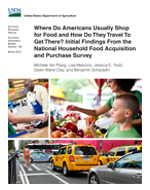Where Do Americans Usually Shop for Food and How Do They Travel To Get There? Initial Findings from the National Household Food Acquisition and Purchase Survey
- by Michele Ver Ploeg, Lisa Mancino, Jessica E. Todd, Dawn Marie Clay and Benjamin Scharadin
- 3/23/2015
Overview
This report compares food shopping patterns of (1) Supplemental Nutrition Assistance Program (SNAP) households to nonparticipant households, (2) participants in the Special Supplemental Nutrition Assistance Program for Women Infants and Children (WIC) to nonparticipants, and (3) food-insecure to food-secure households.
Errata: On September 13, 2016, ERS revised the categorization of households with members categorically eligible for WIC to exclude households where the only categorically eligible member was a child age 5. These children were incorrectly included previously; imputed income measures were also used as these measures became available since the report’s release; revised survey weights were also used to update all estimates in the report. Because of these changes, all of the estimates in the report have been revised. However, the results were not numerically or substantively different after these revisions were made, with one exception— the result that WIC participants were more likely to use supercenters as their primary store was no longer statistically significant. The text has been adjusted to reflect all of these changes.
The results from EIB-138 were used in three ERS Charts of Note dated March 23, 2015; July 15, 2015; and August 11, 2015; and an Amber Waves feature article “Most U.S. Households Do Their Main Grocery Shopping at Supermarkets and Supercenters Regardless of Income,” dated August 3, 2015. For all but the August 11, 2015, Chart of Note, changes in estimates were not numerically or substantively different. In the August 11, 2015, Chart of Note, the difference between WIC participants’ and nonparticipants’ choice of supercenters as their primary stores was no longer statistically significant.
Download
-
Entire report
Download PDF -
Report summary
Download PDF -
Download zip file for eib138
Download ZIP


